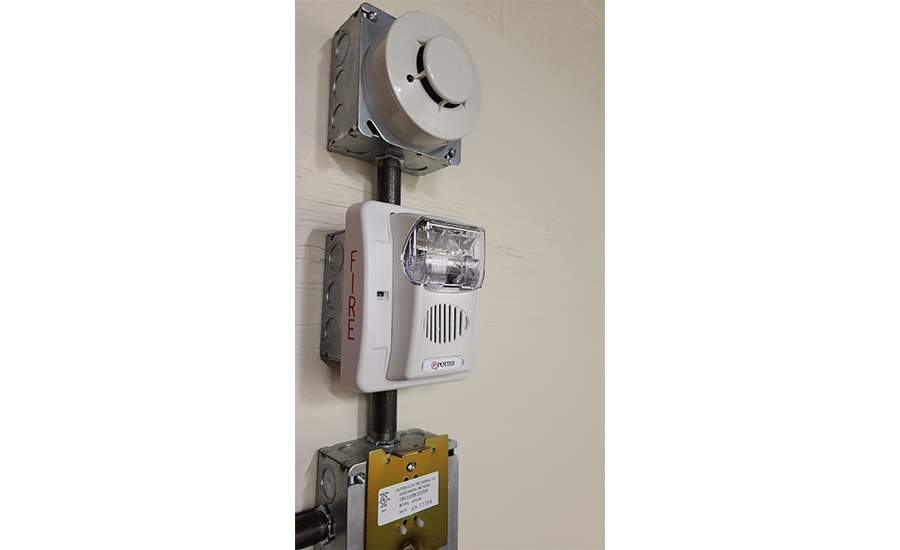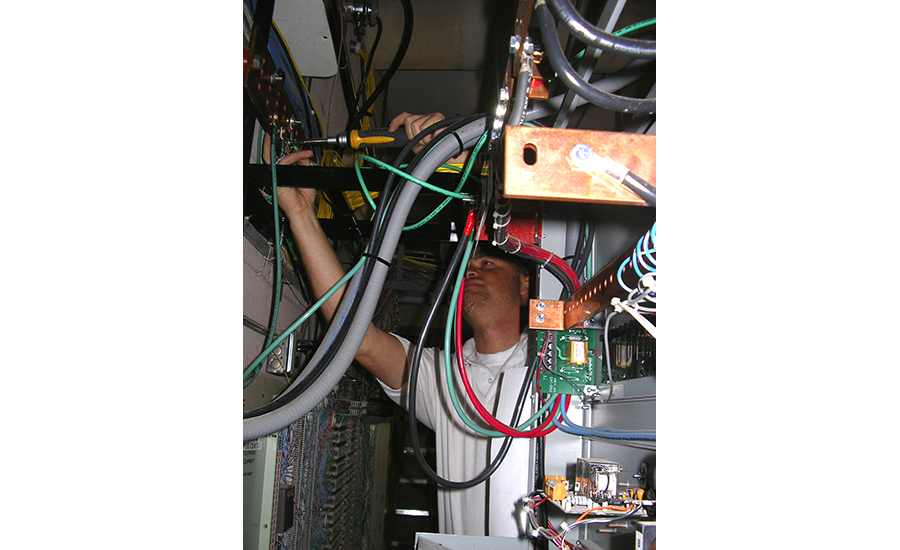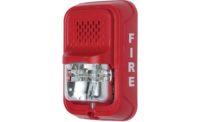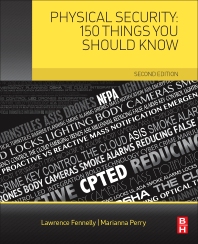What good is a fire alarm system without an effective means of notifying building occupants when there’s a fire in progress? Not much. It’s almost as bad when the wrong notification appliances are installed because it increases the chance of deaths and injuries among those within the structure. This is why it’s important to know a thing or two about fire alarm notification appliances and the fire alarm control panels (FACPs) they connect to.
With this in mind, on a room-to-room basis, the fire alarm system designer must know all sorts of things about the environment. Otherwise it may not be possible to determine the correct specifications of the notification appliances required. Included in this assessment is the technologies used to operate them, the visual characteristics of the strobes, and the right audible components used to gain attention.

This tall order depends largely on the type of FACP specified for the job, in addition to any notification appliance circuit (NAC) power supplies, the size of each room, the ambient noise level within them, and the specific requirements set forth by the local Authority Having Jurisdiction (AHJ). When all of these and other criteria are combined, the fire alarm designer is ready to assemble the right set of specifications for the job.
6 Basic Notification Appliances to Choose From
The occupants of any building must be given ample warning so they can take proper action. Do they evacuate the building or flee to a specific Area of Refuge (AOR) within it? In this case, for starters, the occupants require specific instructions based on where a fire is detected. To this end, notification appliances are necessary at every level to notify people so they can take immediate, appropriate action. Seconds count when there’s a fire.
In reality, there are six basic types of notification appliances in use. They are:
- Audible: A notification appliance that alerts occupants by way of hearing.
- Exit Marking Audible: A device that marks all exists and AOR’s by audible means.
- Textual Audible: A device that conveys specific instructions using audible means.
- Tactile: A notification appliance that warns occupants by the sense of touch or vibration.
- Visible: A device that notifies the occupants of a fire by way of light.
- Textual Visible: A device that displays visual alphanumeric data.
Of course, the most commonly used notification appliances are the Audible/Visible and Textual Audible/Visible, both of which we cover in some detail in this article. We’ll also refer to them as horn/strobes (H/S) and speaker/strobes (S/S), respectively.
“The most common notification appliances are horns, strobes and horn-strobes, as well as speakers and speaker-strobes,” says Chris Hill, global product manager, notification, with Edwards/Kidde Systems, Bradenton, Fla. “Horns alert occupants with the Temporal 3 tone as prescribed by NFPA (Section 18.4.2.1, NFPA 72, 2019 Edition), while voice evacuation systems using speakers expand the flexibility of the system and can send specific messages or tones depending on the application.”
Jillian Harsch, senior product marketing manager for Fire, ADI Global Distribution, Melville, N.Y., agrees. “We’re seeing more than half of our NAC device sales come from the horn-strobe category. While fire bells are still in use, they represent a small portion of our NAC device sales and it is not a growing sector of the category.”
The notification appliance pictured is installed only feet from this hotel entrance, although it can be installed up to 15 feet away — 15 feet from the end of corridors with no more than 100 feet apart.
IMAGE COURTESY OF ALLAN COLOMBO
Proper Placement & Mounting of Fire Alarm Notification Appliances
There’s a time and a place for everything we do in a fire alarm system, and this especially pertains to the placement of notification appliances. The bible of the industry on this is NFPA 72, National Fire Alarm and Signaling Code, published by the National Fire Protection Association (NFPA).
One of the most important areas where notification appliances are needed is near building exits. NFPA refers to these devices as exit marking audible notification appliances. According to Section 3.3.173.1.1, NFPA 72, 2013, they’re defined as: “An audible notification appliance that marks building exits and areas of refuge by the sense of hearing for the purpose of evacuation or relocation.”
The notification appliances used to mark exits and areas of rescue (AOR) within a building must, by code, emit an audible sound that’s distinctly different than the 3-pulse temporal pattern used by all others.
Ordinary audible-only notification appliances must be installed at least 90 inches above floor level and no closer to the ceiling than 6 inches. Combination audible/visual devices are installed so the lens of the visual element is no less than 80 inches and not more than 96 inches above floor level. Where the wall height will not allow mounting at the 80-in. minimum height, install them no closer than 6 inches from the ceiling.
The number of notification appliances required in a room or corridor, as well as other aspects of notification, is determined by tables in Chapter 18 of NFPA 72. To purchase or to review the most current version at no cost, go to www.nfpa.org.
Notification Appliance Technologies
There are two basic technologies used with today’s popular notification appliances. They are: 1) raw voltage, and 2) data of one kind or another. The H/S makes use of 12 Volts Direct Current (VDC), 24VDC, and 120 Volts Alternating Current (VAC) — the last of which is often used with sprinkler systems.
“If a fire alarm system is not required by code (i.e., the system is only required to have a sprinkler monitoring system but not a full manual or automatic fire alarm system), you would only be required to have an outdoor audible/visual or visual device at the location specified by the AHJ (Authority Having Jurisdiction),” says Todd Domer, director of engineered systems with Gene Ptacek and Son Fire Equipment Co. Inc., Cleveland. “Generally, today, the AHJ wants the notification device located at the outside of the riser location so they can find the riser easier when the trucks pull up to the building during an alarm.”
With regard to S/S notification appliances, they use audio over the speaker portion and 12VDC and 24VDC for the strobe (either traditional Xenon or LED). “Due to the synchronization requirements, notification appliances usually have an issue with power consumption,” Hill explains. “Strobes are now employing LED technology along with new electronic designs to reduce current draw for the systems.”
When it comes to the source of voltage and audio that makes them work, there are several FACPs on the market that perform in a variety of ways. For example, a traditional FACP is designed to provide raw 24VDC from a single set of alarm outputs on the motherboard. Although 12VDC may be used to a limited extent, 24VDC is, by far, the most common voltage employed in commercial work.
Horn/strobe supervision is achieved by passing a small current through the NAC up to each device with the voltage reversed at the panel’s output. A diode in the H/S prevents it from entering the notification appliance itself. When an alarm occurs, the voltage is reversed, causing the diode to conduct, passing current to the device so the audible and visual will work.
Speaker/strobe devices are supervised in a similar manner. A small DC passes through the circuit up to each device during standby. A capacitor inside each unit prevents this DC supervisory current from entering a matching transformer inside the unit. When there’s an alarm, the panel switches to a high-impedance, constant-voltage audio power amplifier that pushes verbal instructions over either a 100-Volt (EU), 70-Volt or 25-Volt line.
When installing speaker/strobe notification appliances, to preserve audio ineligibility, be careful not to install the audio NAC closer than 10 in. per 100 V when in parallel with high-voltage cables.
IMAGE COURTESY OF ALLAN COLOMBO
Proper Installation is Key to Audio Intelligibility
There was a day when an overwhelming percentage of notification appliances installed in the United States were horn/strobes. However, in recent years that has changed because of mass notification systems and increasing use of audio speakers instead of audible horns. Intelligibility is becoming such an issue that NFPA has written it into NFPA 72, National Fire Alarm and Signaling Code.
“One of the biggest problems I have seen lately is on all sorts of fire alarms there are noise issues,” says John Pecore, power quality engineer and owner of Stormin Protection Products Inc., St. Petersburg, Fla. “Sometimes we have radio coming across the speaker wires. In the lab, the fire alarm works great, but as soon as we add a lot of inductive wire between buildings, and the fact that the fire alarm panel’s pico farad (pf) capacitance is low compared to earlier models, we have a lot of noise — usually white noise, but if a radio tower is nearby, music comes across the line.”
One cause of this is the close proximity of NAC wiring to electrical cables inside walls and ceilings. One way to avoid induction between nearby high-voltage (120 and 240 VAC) wire and NAC cable is to maintain at least 10 inches of space between low-voltage cables and nearby 120-VAC electrical wire, 20 inches for 240 VAC.
Another issue involves a lack of bonding between multiple building grounds when a single FACP serves an entire campus complex. “The cure for this is to run a No. 14 gauge green wire along with your NAC and Signaling Line Circuit (SLC) wires building to building and bonding them to the building AC (Alternating Current) power ground,” Pecore says.
Zoning Notification Appliances in Large Buildings
Many of the larger FACPs on the market can use multiple “bell” output boards that contain their own isolated set of alarm contacts for zoning purposes. The intent of this arrangement is to enable the designer to utilize H/S devices that operate independently of one another. This gives the designer the ability to alert people based on things like the building they’re in, specific risks that need to be considered, where they are in relation to the nearest means of exit discharge, and other criteria.
This concept centers on creating physical zones. According to Section 3.3.320, NFPA 72, 2013 Edition, a notification zone is: “A defined area within the protected premises. A zone can define an area from which a signal can be received, an area to which a signal can be sent, or an area in which a form of control can be executed.”
The other type of FACP, called an emergency voice/alarm communication (EVAC) system goes one step further by providing specific instructions on what to do using prerecorded messages and/or live voice prompts. Like the use of independent H/S units, this allows the designer to address a wide variety of notification needs.
A signal/strobe device can be employed where the speaker conveys verbally intelligible instructions at an appropriate sound level. The strobe portion of the S/S works in the same manner as an H/S device. It provides a visual means of notifying occupants that there’s an issue they need to know about. In some systems, it’s not fire alone that the FACP serves — perhaps storm warnings.

Pictured is a typical notification appliance installed in conjunction with the required smoke detector and manual pull station at a building's fire sprinkler riser.
IMAGE COURTESY OF GENE PTACEK AND SON FIRE EQUIPMENT CO. INC.
Notification Appliances & Synchronization
The need to synchronize notification appliances on a floor-by-floor basis is based on three things: viewing of non-synchronized strobes by those diagnosed with photosensitive epilepsy can cause seizures; audible signals left to operate without synchronization can cause disorientation among the occupants of a burning building; and it’s required by NFPA 72, National Fire Alarm and Signaling Code as well as others, such as ADA (Americans with Disabilities Act).
“I can install three makes of notification appliances on three different floors of a building and program my fire alarm panel to synchronize each floor using the synchronization format native to each manufacturer,” says Todd Domer, Gene Ptacek and Son Fire Equipment Co. Inc.
Domer says that FACPs for several years have had synchronization protocols built in for System Sensor, Gentex (Potter), and Wheelock. “They can have the two-wire horns and strobes and can silence the horn while leaving the strobe flash through panel programming.”
While code says that you have to synchronize horn/strobe units, when there are more than two that can be viewed simultaneously, many professionals will advise that you sync those, too, because many AHJs will want it done. And even though you might win the argument — because of Sections 18.5.5.4.2(3) (rooms) and 18.5.5.5.7 (corridors), NFPA 72, 2013 — it could adversely interfere with your long-term working relationship with the local AHJ.
How to Choose the Right Notification Appliance
One of the most obvious issues on a fire alarm engineer’s mind is how to select the right notification appliance devices for each location in a building. There are at minimum three considerations that must be taken into account: 1. the ambient sound level in each room, hallway, bathroom, conference room, office area, place of assembly, etc.; 2. the physical size of these areas; and 3. whether each location falls under private or public mode, per code.
The exact sound output of these devices hinges on whether they’re used in public or private spaces. Examples include hallways versus maintenance rooms; or meeting rooms and offices versus storage areas. The sound output of notification appliances used in public areas must exceed the average ambient sound level by 15 dB, or 5 dB above the loudest ambient sound with a duration of 60 seconds or more at a height of 5 feet above floor level (AFL). Notification appliances used in Private Mode must exceed the average ambient sound level by 10 dB with the same 5 dB difference with respect to maximum.
“Designing a speaker layout for such a space is part art and part science. By taking ambient sound measurements in the building/area, we can provide guidance for a layout with enough power for the signals to be heard, accounting for ceiling height, dimensions, building contents (such as a warehouse with rows of storage racks, or an open space like a hanger),” says Brian Rocket, national sales manager with Signal Communications Corporation of Woburn, Mass. “Intelligibility is crucial, and many AHJs now test for that. Another rule of thumb is more speakers at less volume work better than fewer speakers at high volume.”
Sleeping rooms are subject to the same set of sound criteria, with the exception of ambient sound levels measured at the pillow instead of 5 ft. AFL. “520Hz audibles are also a trend, since low frequency quasi-square waves sounds proved more effective at waking people with hearing impairment compared to common high pitch tone horns,” says Paul Dorion, senior engineer with Mircom Group of Companies of Montreal. “There are technological challenges to overcome, since a specific harmonic content is required and low frequency transducers are much more difficult to design.”
The task of choosing the right notification appliances for a job is complicated and sometimes difficult. It’s impossible to provide all the tools necessary to make every decision from start to finish within a single article. In order to make the right decisions in every location of a fire alarm system, it’s necessary to have the right information as well as a firm understanding of the technologies involved and fire code as contained in NFPA and ICC (International Code Council) codes, as well as third-party testing and listing standards.
To learn more about this topic, there are organizations that can help you prepare for a successful career in fire alarm engineering, installation, testing, and service. For example, ADI Global Distribution offers educational opportunities, Harsch says. “ADI Academy allows dealers to participate in industry and product training anytime, anywhere,” she says. “The on-demand training platform offers a variety of fire courses around codes and standards, installation techniques and more.”
In addition to ADI, look to NFPA, National Training Center, and National Technology Transfer, which provide a full regiment of training courses as well as certifications.











